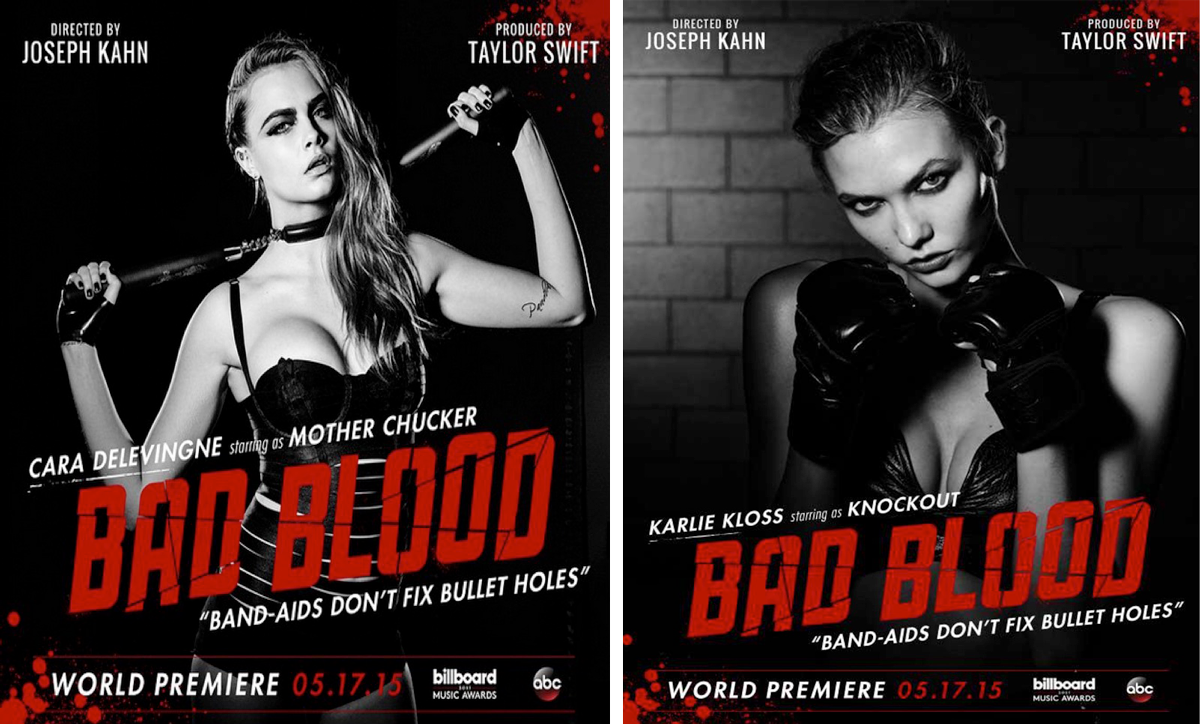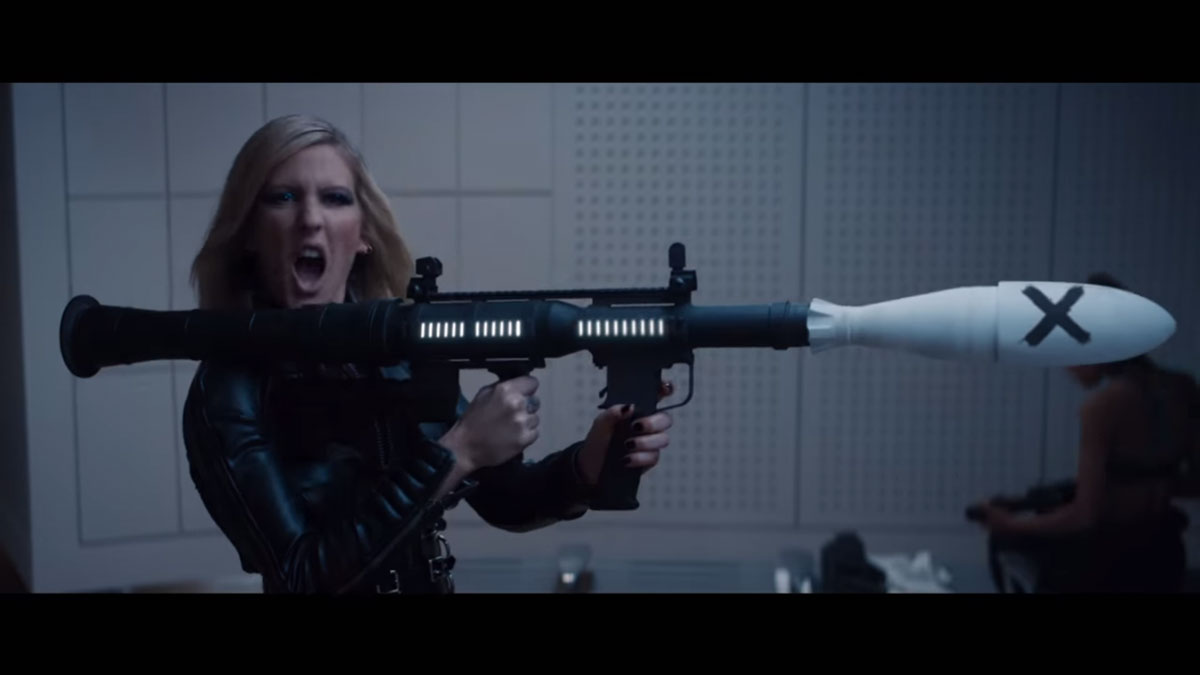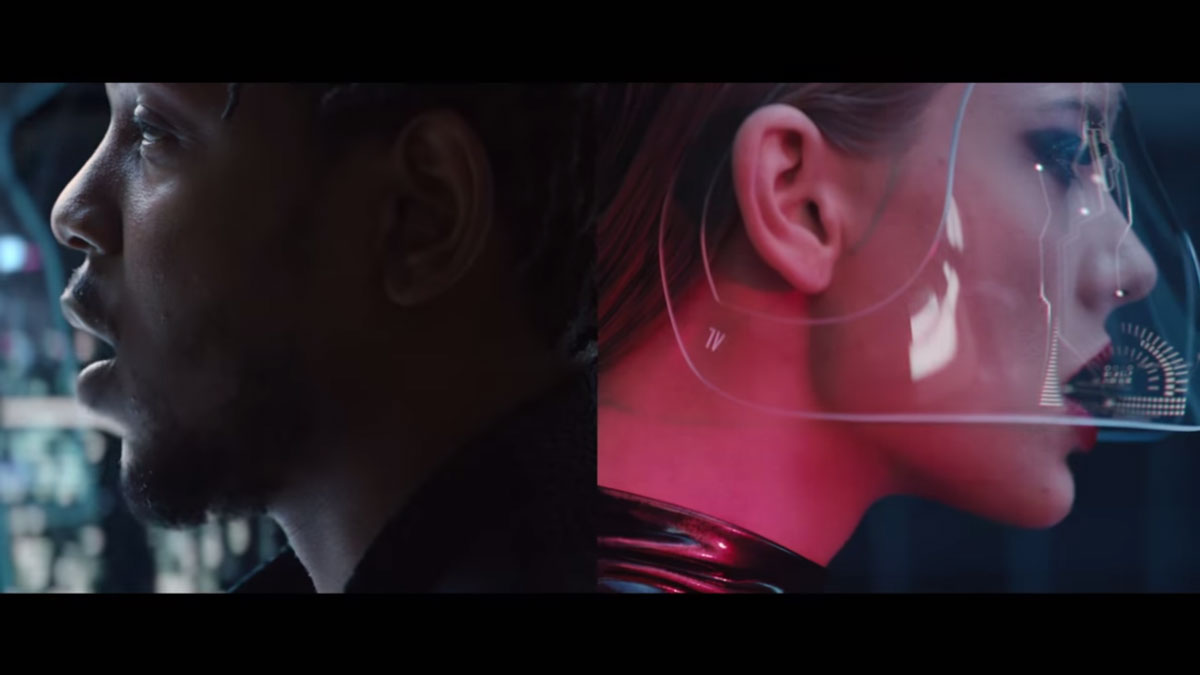14 — July 2018
Bad Blood
Taylor Swift ft. Kendrick Lamar
“Bad Blood”
© 2015 Big Machine Records, LLC
Director: Joseph Kahn
(YouTube)
The Feminist Manifesto by Taylor Swift: Boss Babes, Fit Girls and Welvin Da Great
Hannelore Roth
Phantasies of all-female societies have been a constant source of inspiration for writers and filmmakers. Yet, rather than proposing a happily-ever-after, these literary and filmic experiments often entail a structure of repressed violence that can erupt any minute. One of the most compelling examples in literature is Heinrich von Kleist’s 1808 Amazon play Penthesilea. Depicting an at first sight emancipated women’s state that is founded on Rousseau’s social contract, the play seems to explore the possibility of a non-patriarchal, modern society. Unlike their previous subjection to the male foreign rule of the Ethiopian tribe, which invaded their former country and killed all the men, the citizens of the new Amazon state are sovereign; the queen only has the executive branch at her disposal. But appearances are deceiving. Not only is the barbarian raid of the Ethiopians systematically reproduced in the state government of the Amazons – to ensure the further existence of the state, the god Mars annually sends a selected group of virgins to war to capture men who can impregnate them. Moreover, when we take a closer look, the true foundational act of the state does not lie in the social contract, but in the violent self-mutilation of Queen Tanaïs: in order to muzzle the insecure citizens, who doubt whether they will be able to maintain themselves against hostile men, she heroically rips off her right breast. This symbolic gesture, which is actually meant to be the decisive step towards an autonomous state, brings the seemingly emancipated women back to the mother’s breast and literally subordinates them to the queen’s body. In this way, the ostensibly modern, egalitarian state is brought back to its archaic, premodern conditions, as the future generations are forever tied to the primitive mother. The brutal lapse of the present queen Penthesilea precisely originates in the violent structures on which the women’s state is built. At the end of the play, she tears, together with her dogs, her beloved Achilles to pieces and commits suicide.
Another example of an all-female community ‘gone wild’ came out on the big screen only recently: Sofia Coppola’s uncanny thriller The Beguiled (2017) shows an almost deserted girls’ school during the American Civil War, with only 4 students, the teacher Miss Edwina and the headmistress Miss Martha remaining. While the youngest student Amy is out in the woods searching for mushrooms, she finds a soldier whose leg is wounded, and takes him to the girls’ school. During his recovery, this unwelcome guest / prisoner disrupts the seemingly stable order marked by rigid decorum and tightened corsets. The battleground is brought indoors: the tight-knit sisterhood finds itself competing for McBurney’s favor as he manipulates the vanities and insecurities of the girls. The rivalry comes to a climax when Miss Edwina, who is waiting in her room for the corporal to come, catches him in bed with one of the other girls, loses her self-control, and pushes him down the stairs. Under the guise of saving his life and with silent consent of Miss Edwina, Miss Martha then decides to cut off his badly wounded leg. By this “art of castration” – the corporal’s words – Miss Martha not only takes revenge for not coming into her room, but also tries to bury the destructive feelings of desire and lust seething and simmering under the gilded surface of the girls’ school. And this is taken quite literally, since the women bury the leg together in their garden. But the precarious order is not re-stabilized before they have the corporal killed. After serving him poisonous mushrooms, they are symbolically holding hands at the dinner table.
Against the background of these pathological scripts of female rule I would now like to discuss the imagination of an all-female community in contemporary pop culture, which has been celebrated by national and international newspapers and magazines as a feminist manifesto: the 2015 music video Bad Blood by the newly crowned queen of pop Taylor Swift. Before premiering at the opening of the Billboard Music Awards on the 17th of May 2015, this big-budget visual spectacle by Joseph Kahn about the deceitful betrayal of a close friend became one of the most pre-hyped music videos of all time. Swift was teasing the internet for days about the horde of female celebrities who would make their appearance in the video. Singers, models and actresses such as Selena Gomez, Ellie Goulding, Cara Delevingne, Karlie Kloss and Lena Dunham all got poster treatment in the neo-noir style referencing the 2005 film Sin City, announcing them as futuristic crime fighter characters with ominous names such as Knockout, Slay-Z, Destructa X or Mother Chucker, who were ready to ‘kick your ass’ (or that of popstar and former friend Katy Perry for that matter, since the video has widely been interpreted on internet fora as a middle finger to Perry, who reputedly ‘stole’ Swift’s backup dancers for her tour).

But rather than a classic female revenge story, the video has been read as a narrative of female empowerment which even takes on planetary proportions: “We weren’t emotionally prepared when she actually released [the music video]”, the Huffington Post writes, “because not only did the video slay in every way, it taught a bigger lesson to the world than we were expecting.”1 According to the American magazine The Atlantic, Swift is “on a bigger mission”, as the video “zanily explodes conventions around gender and action movies.” Instead of being entirely defined by their gender, “the Bad Blood-women have their own signature powers, gear, and personas – imagine that!”.2 The Huffington Post describes the “moral” of the sometimes disconnected story line as follows:
“Don’t let someone take you down and let you stay there. You get up, you brush yourself off, and then you go ahead and slay the world with your women who are killing it. Show the antagonists of your life that you’re not weak like they think you are. Instead, you should create a forceful, compelling squad to hang out with […] and you will prevail. That’s exactly what Catastrophe did in the ‘Bad Blood’ music video. She allowed her weakest moments to shape her into becoming the best and most robust version of herself. And that’s exactly what Taylor Swift did with her own life, and that’s EXACTLY what you should be inspired to do with YOUR LIFE. Tipping you a nod and grin, because you got this.”3
#Bossbabe
The discourse of this young female blogger of the Huffington Post is revealing about how female power is often understood today. Emphasizing an in fact hyper-individualistic notion of girl power, her discourse fosters the idea of the strong and successful young woman, who is the manager of her own life and takes control. Postfeminism collaborates with neoliberal politics here: Catastrophe’s and Swift’s own impressive comeback are understood as the sovereign decision of a self-governing and entrepreneurial individual, which should also inspire you. Of course, this seemingly optimistic discourse also has a disenchanting downside: when you are responsible for your own success, a possible failure is nothing but your own fault and you just have to work harder to achieve your #lifegoals. The pink mantras that circulate on the internet under the hashtag ‘bossbabe’ or ‘girlboss’ cultivate this kind of logic: “What if you just DECIDED you believed in yourself?”, “Oprah didn’t use excuses”, or “A #GIRLBOSS is in charge of her life. She gets what she wants because she works for it.” This neoliberal image of the strong, self-empowering woman colonizes original feminist values such as inclusivity and equality. It spotlights a very exclusive group of women – young, sexy, predominantly white and middle- or upper-class – who have access to this type of lifestyle. The battery of A-list celebrities that Swift mobilized for her video is a hyperbolic version of this alliance between postfeminism and neoliberalism. Under the hashtag ‘squad goals’ or ‘blessed women’ Swift constantly plays up this same-sex friendship in social media, crowning herself the ringleader of this glamourous “squad” or, how it is also referred to in the media, “crew”, “gang” or group of “pals”. These notions signify that the cultural templates we have for denoting a powerful person or collective remain resolutely male.4
#Fitgirl
This language of stereotypical masculinity was also prevalent in the Huffington Post blog: you have to shape yourself into your “strongest”, most “forceful” and “robust” version; only then you will be able to “prevail” and “slay” the world with your killer women with ditto bodies. This muscled cult of hardness and ruthlessness wrapped up as female empowerment is in fact both a theatrical exaggeration of masculinity and an inversion of the existing gendered power relations. We don’t need Freud to see the shooting bazooka of Ellie Goulding a.k.a. Destructa X as an implied claim to phallic power. [03:31]

These gendered power relations are not infrequently constituted through the body. It is therefore not surprising that the Bad Blood women start with a special training program which resonates with our contemporary cult of fit and strong female bodies. Under the hashtag ‘fit girl’ or ‘fitspiration’ devotees post (filtered) pictures of their gym-tight abs and rock-hard booty. Not only can this disciplining of the body be seen as an effort to compensate for the sociopolitical impotence of women – the aesthetics of the flawless female body is then perhaps just a symptom of an unstable order full of ambivalences and unresolved hierarchies. It can also be conceived as a form of socialization of and through the body that joins forces with neoliberal #girlboss politics. By controlling the body, you incorporate precisely those values that matter for a ‘bossbabe’: “As a #GIRLBOSS, you take control and accept responsibility. You’re a fighter – you know when to throw punches and when to roll with them.”5 In this way, the fitness studio or, as in the music video, the boxing ring function as the modern arenas where this new version of female sovereignty is shaped.
But this strong and robust femininity is also very precarious; it has to be constantly staged and re-staged, either through compelling hashtags or daily exercises in the gym. The sudden appearance of a cute teddy bear in the video poses an imaginative threat to the female sovereignty that was gained through pain and constraint; therefore, it is violently skewered. [2:03] Indeed, the #fitspiration language can be brutally reductive: pain becomes progress, short-term interests must be replaced by long-term objectives, weakness is failure. “Remember, ladies, sweat is just fat crying.”6 It is remarkable that this narrative of extreme self-discipline and self-denial, which in the 1970s and 1980s was already denounced as a fascist form of male subject-formation, is now celebrated as a means to female empowerment and emancipation.
Furthermore, rather than paving the way for female liberation, the #strong is the new thin or #strong is the new sexy slogans popping up on Facebook, t-shirts and fitness books impose a new, hypersexualized and quasi-unattainable beauty trend on women, which excludes the majority of them. The music video of Taylor Swift affirms this hypersexualized femininity: examples are the tight-fitting lycra and revealing crop-top outfits with push-up bras, the lipstick that is carefully put on in the middle of the fight [0:10], or the body scan of Swift with a typical male gaze [01:02]. Stereotypically female accessories like a powder compact [1:31] or a handbag [1:53] prove to be deadly weapons, but rather than turning them into more complex, surprisingly emancipating tools, they seem to be nothing more than cool looking gadgets with no new added value or disturbingly ambivalent functions.
Welvin da Great
Let us now take a closer look at how this female rule and all-female community are structured in the Bad Blood clip. The video begins in an office block in London; you see the Tower Bridge lit up from the window. The moon is shining. Although it is late, there are still many male employees present when the main characters, Catastrophe and Arsyn, break in. Indeed, the cultural norm of the never-ending office day in big companies is a symptom of a dominant masculine regime. It not only excludes women from its clubbable boys’ world, but also puts a lot of pressure on the male employees in the high-stake game of promotion. Yet, it is not really a disruption of this system that Catastrophe and Arsyn have in mind. While violently attacking the masked men in suits (an outfit that references the ‘Crazy 88’ gang in Quentin Tarantino’s Kill Bill: Vol. 1), their only goal is to get hold of a mysterious briefcase. They only want to enter the gendered structures of power and turn them upside down without displacing or transgressing them. The metaphorical cut-throat competition that reigns at the workplace becomes reality: Arsyn stabs her sister-in-arms in the back by blowing blush powder in her face, stealing the briefcase and pushing her out of the window. The competitive atmosphere, this survival of the fittest, is brought back to its violent origins: the rest of the music video shows Catastrophe training for the final elimination of Arsyn, who has to pay for her betrayal. In this way, the Bad Blood community takes the form of an archaic family clan, in which honor, duty and loyalty but also revenge and retribution are the organizing principles. The apocalyptic fight that takes place at the end of the video thus becomes a kind of honor killing, by which the taboo of sororicide is avenged by the sisterhood.
But in the end, it is not Catastrophe who is the ringleader of the clan. It is the only male person in this revenge story, Welvin da Great (or Kendrick Lamar), who is shown power posing in his ivory tower with his feet on his desk. [0:50] As a modern Mars, he seems to issue orders through his microphone. In this way, the images that show half of Taylor Swift’s and half of Kendrick Lamar’s face, frontal or – like the Roman God of transitions Janus – from the side [2:58], aren’t a progressive claim for gender fluidity. They indicate that the ‘empowering’ all-female community is just a violent, pre-modern copy of the patriarchal structures at the office, which are built on hierarchic power relations, fierce competition and strategies of in- and exclusion.


This ambivalence is already implied in the structure of the music video. The repetitive imitation of hyper-masculine cultural templates such as the action hero or the biker gang [2:30] certainly contains an element of parody. Yet, it remains unclear if the music video also ironizes the female reproduction of these schemes or un-problematically appropriates them to spread a message of female empowerment. In any case, the reception of the video clip has completely missed this ambivalence. Similar to Penthesilea by Kleist and The Beguiled by Coppola, the seemingly tight-knit sisterhood of the Bad Blood women entails a self-destructive core, which is inflamed by one man: Mars, corporal McBurney or Welvin Da Great. None of these all-female communities offer a tenable alternative for the existing male structures. In the end, the women prove to be nothing but violent copycats: of the Ethiopian raid in Penthesilea, of the Civil War in The Beguiled – you constantly here faint gun shots in the background – and of the savage competition at the workplace in Bad Blood.
Notes
- 1Zalnub Amlr, “The Powerful Message Behind the ‘Bad Blood’ Music Video,” The Huffington Post, 26 May 2015, https://www.huffingtonpost.com/zainub-amir/the-powerful-message-behind-the-bad-blood-music-video_b_7445638.html (accessed 9 July 2018).
- 2Spencer Kornhaber, “Taylor Swift’s ‘Bad Blood’ Video Is the Anti-Avengers,” The Atlantic, 18 May 2015, https://www.theatlantic.com/entertainment/archive/2015/05/taylor-swifts-bad-blood-is-exploding-what-exactly/393527/ (accessed 9 July 2018).
- 3 Amlr, “The Powerful Message Behind the ‘Bad Blood’ Music Video”.
- 4 Mary Beard, “Women in Power,” London Review of Books 39, no. 6 (16 March 2017), https://www.lrb.co.uk/v39/n06/mary-beard/women-in-power (accessed 9 July 2018).
- 5JErica Statly, „What is a girlboss?,” 18 April 2018, https://www.ericastatly.com/what-is-a-girlboss/ (accessed 9 July 2018).
- 6 Anna Kessel, “Why has women’s fitness become a beauty contest?,” The Guardian, August 22, 2016, https://www.theguardian.com/commentisfree/2016/aug/22/sport-is-supposed-to-be-about-fun-not-body-image (accessed 9 July 2018).
